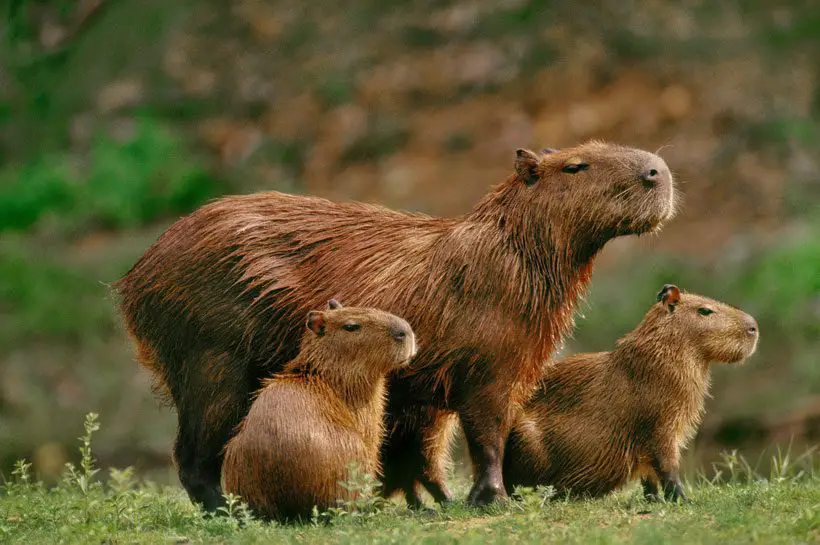Why Capybaras Are So Friendly? – Let’s Find Out!
Capybaras are the world’s largest rodents, weighing up to 150 pounds, and are native to South America. Capybaras also possess an array of fascinating traits that make them stand out in the animal kingdom.
Perhaps one of the most striking characteristics of Capybaras is their unparalleled friendliness. These social animals are known for their ability to forge deep bonds with a range of species, including humans. It’s no wonder that some people even keep them as pets in certain parts of the world!
But what makes Capybaras so friendly? Capybaras are naturally laid-back and sociable creatures who prefer being in groups. They have also been domesticated for many years and have gotten used to being around people, which may help explain their friendly behavior.
In this article, we will go into greater depth on how friendly Capybaras are. We’ll look more deeply at their behavior, biochemistry, and the factors that influence their friendly demeanor.
What Elements Contributed To The Capybaras Evolution Into A Friendly Rodent?
Capybaras are fascinating animals that have won many people over with their cute appearance and friendly behavior. It is believed that a mix of environmental and social factors contributed to the Capybaras’ evolution into friendly rodents. Some factors that might have aided in this evolution include:

Large size
Did you know that Capybaras are the largest rodents in the world? The size of Capybaras may have contributed to their increased calmness and decreased aggression in the presence of predators.
These calm rodents can live their lives peacefully since their large size may have made them less vulnerable to predators.
Low rate of reproduction
Typically, female Capybaras will have one litter per year, each containing two to eight offsprings. This may seem low compared to the reproductive rates of other rodents like mice and rats, who can have multiple litters per year with up to 10 or more offsprings per litter.
Due to their social nature and propensity for living in groups, they are social creatures whose survival depends on the well-being of each individual. It’s amazing to think how the evolution of Capybaras’ friendly attitude may have been influenced by their low reproducing rate.
Living in large groups
Capybaras are highly social animals that live in groups, called herds. Living in a social group may have promoted friendly behavior, as it is essential for Capybaras to get along to maintain group cohesion.

Absence of inherent aggression
Capybaras are not known for their aggression. Actually, Capybaras are more likely to run away from a threat than to fight it. It’s interesting to know that they may have developed this non-aggressive behavior through time, which has helped them gain a reputation for being amiable animals.
Domestication
Did you know that Capybaras have been domesticated in some parts of the world? This may have contributed to their naturally friendly behavior since they have been selectively bred for docility and ease of handling.
Many people keep Capybaras as pets because of their gentle nature. And due to their social nature, they often get along well with other animals like dogs and cats.

Living near water
Capybaras have a lot of opportunities to relax and unwind because they live in an aquatic habitat. This may be why they are less aggressive than some other animals.
Due to this adaptation, they are now more comfortable around people who like water-based activities like swimming or boating.
Developed sense of empathy
Capybaras are able to recognize and react to the emotions of other animals because they have a highly developed sense of empathy. This can make them more attuned to the needs and behaviors of other animals and may contribute to their friendly and cooperative behavior toward others.
What Are The Positive Effects Of Capybaras’ Friendly Attitude?
They have a reputation for being kind and for forming strong bonds with both people and other animals. Here, we have covered the benefits of Capybaras being friendly animals.

Helps to reduce stress
Humans can experience a reduction in stress and anxiety by spending time with Capybaras. Your pulse rate and blood pressure can be lowered by their calming presence, which will help you feel more at peace and at ease.
In addition, touching or stroking a Capybara might cause the production of endorphins, which are brain chemicals that lessen pain and increase pleasure.
Improved socialization skills
Spending time with Capybaras helps promote socialization, especially for people who may find it difficult to engage with others. These amiable creatures can offer you a sense of comfort, making it simpler to interact with people.
Studies have actually demonstrated that interacting with animals can lower social anxiety and enhance social abilities. National Institutes of Health found that kids with autism spectrum disorders do better socially when they are around friendly animals.

Helps to reduce loneliness
You should think about getting a Capybara as a pet if you are feeling lonely or isolated. These cheerful animals make great companions and can bring you happiness and comfort.
Furthermore, as they are simple to care for and don’t need much attention, they can make wonderful pets for people who want a low-maintenance animal.
Used for educational purposes
Capybaras have an engaging personality that can make learning about them a fun and interesting experience. That’s why they are often featured in educational programs to promote conservation efforts and inform people about their behavior, habitat, and diet.
What Factors Can Influence The Friendly Behavior Of Capybaras?
The friendliness of Capybaras can be influenced by a variety of internal and external factors. I have provided a table below listing the following factors.

Age of the Capybara
Young Capybaras are curious and may approach people more readily than older ones. However, they can get easily scared due to being preyed upon by animals such as foxes,caracaras, and black vultures.
Gender of the Capybara
Both male and female Capybaras can be friendly towards humans if they have been socialized to human presence from a young age. However, male Capybaras may be more aggressive during breeding season or if they feel threatened, while females may be more protective of their young.
Physical Condition
A healthy Capybara that is free from any disease or injury is more likely to be easy to get along with people. However, if a Capybara is sick or injured, it may feel more vulnerable in the presence of humans, causing them to be defensive or aggressive toward any perceived threats.
Past interactions
Capybaras’ behavior towards humans may be influenced by past interactions. Positive experiences, such as being cared for and receiving treats, can lead to friendliness, while negative experiences, such as abuse or threats, can cause wariness and defensiveness.
Anxiety levels of Capybaras
Capybaras’ behavior depends on their mood and environment. When they are calm, they are amiable, but under pressure, they can become hostile. It’s better to give them space and avoid needless encounters if you observe symptoms of tension, such twitching or a lifted tail.

Availability of food and water
Capybaras are friendly when resources are abundant, but can become hostile and territorial when resources are scarce. As they must protect their resources in order to survive, they might be less inclined to share with other animals.
Existence of potential predators
The Capybaras may act more nicely toward other animals if they feel safe and secure in their surroundings. For instance, they might be more laid back and eager to participate in social activities if they are residing in a location with low predator density or if they have developed a strong social group.
Changes in the climate
Capybaras require water for drinking, bathing, and regulating body temperature. Changes in weather and rainfall can affect their water supply, which affects their behavior.
During droughts, they may become aggressive due to resource competition, while during floods, they may be more relaxed and social.
If you’re interested in learning more about capybara sounds, you might find our article on capybara sounds helpful. It explores the different vocalizations and sounds made by capybaras, providing insights into their communication and social behaviors. Additionally, if you’re curious about capybaras’ swimming abilities, our article on capybara swimming discusses their natural affinity for water and their remarkable swimming skills.FAQs
If you want to know more about the friendliness of Capybaras, here are some FAQs on them.
Q: How do Capybaras interact with people to show their friendliness?
Capybaras show their friendliness to people in a number of ways. They may rub up against people or other animals and allow people to pet or scratch them. At the same time, they make a range of noises, including whistling, purring, and barking.
Q: Are there any risks associated with interacting with Capybaras?
Yes. There is a chance of getting bitten or scratched when engaging with Capybaras. If threatened or scared, Capybaras may bite you with their sharp teeth and claws. Thus, it’s crucial to approach Capybaras gently and carefully.
Q: What impact does Capybaras friendliness have on their conservation status?
Capybara populations are stable in many regions of South America, therefore they are not now regarded as a threatened species. However, due to their friendliness, they are frequently hunted and captured for both their meat and as pets.
Final Words
In conclusion, we now know that Capybaras are friendly animals. This is due to a combination of factors, including their social nature, their ability to form strong bonds with other animals, and their tendency to live in large groups.
It’s interesting to note that Capybaras developed their friendliness as a means of survival. Their reliance on social ties aids in their defense against predators in the wild. It’s difficult not to love and admire these beautiful animals given their friendly behaviors and willingness to interact with humans.




